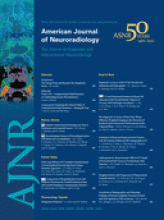I read with interest the article titled “Interpretation Errors in CT Angiography of the Head and Neck and the Benefit of Double Reading” by Lian et al1 in the December issue of the American Journal of Neuroradiology. I think that the analysis offered by the authors would be even more useful if they had provided the following additional information:
1) The phenomenon of “satisfaction of search” is known to be responsible for perceptual errors in radiology. For example, if a patient has an intracranial CTA for left Sylvian fissure predominant subarachnoid hemorrhage and an MCA aneurysm is identified, it is probably more likely that an additional small aneurysm or completely unrelated finding will be missed because the radiologist can “relax” now that the patient's problem has been identified. Conversely, if the expected aneurysm is not found, the radiologist will look very long and hard for any other aneurysm or an alternative explanation for the hemorrhage. Did satisfaction of search play a potential role in the patients with missed findings in this study?
2) Given the large volume of information on CTA, the radiologist tends to expend the greatest effort trying to identify the most clinically relevant abnormalities. As such, it would be useful to know whether more vessel occlusions were missed in patients being studied for intracranial hemorrhage and more aneurysms were missed in patients being evaluated for stroke.
3) The amount of information in a stroke protocol is approximately double that of either the intracranial or carotid protocols because both the head and neck are studied in the stroke protocol. Was the miss rate higher on these double studies compared with the single studies? The authors also do not provide a breakdown of the number of each type of protocol in the “Results.”
4) It would be interesting to know whether the miss rate was higher for studies interpreted “on call,” when the radiologist necessarily works more quickly, compared with studies performed during the day.
5) The age of the patients was reportedly recorded, though the information is not provided in the “Results. ” Elderly patients are more likely to have multiple abnormalities, incidental or otherwise. Were there more missed findings in elderly compared with young patients?
6) As defined by the authors, the term “significant” discrepancy is somewhat ambiguous. We are not provided with any specific demographic information regarding the patients with missed findings. Is a 1-mm aneurysm in a 75-year-old patient a “significant” finding? Is an A2 occlusion in a 90-year-old patient with subarachnoid hemorrhage a “significant” finding? Can the authors give examples of “minor” discrepancies?
7) Five radiologists were the initial readers of the CTA studies, including 3 with a great deal of experience (16–35 years). Was the distribution of errors equivalent among all of the radiologists? Was there a disproportionate number of errors by a particular radiologist, which could have skewed the results unfavorably?
I believe that this additional analysis would strengthen the results of this provocative article.
Reference
- 1.↵
- © 2012 by American Journal of Neuroradiology







